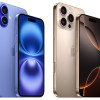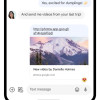Review: iPhone
After being exposed to hundreds of pictures, commercials, and videos - probably more than most people - we thought we had a good idea what the iPhone looked like. From the front, the iPhone matched our expectations fairly accurately. The face is a smooth dark sheet of glass with a cut out at top for the speaker and the bottom for the main menu button. This button is a physical key with a nice click to it, and not simply a touch sensitive area below the screen. Because it is narrower and thinner than most QWERTY smartphones, the iPhone gives the illusion that it is longer than your average Treo or E61, but it is the same length (not including the extra length of older Treos' antennas).
All the pictures and videos you see don't really show how narrow or, more surprisingly, how thin the iPhone is. Calling it the nano of QWERTY phones would not be an exaggeration. The totally rounded edges makes the iPhone look and feel even thinner as your hand wraps tightly around its ultra slim profile.
The sleep button at the top, the volume keys and the silence switch on the left each have hard edges that make them easy to feel against the otherwise smooth profile. Each sticks out just enough that they are equally easy to operate. However it is not easy to tell by looking that the silence switch is just that - a switch - and moves towards the front or back of the phone.
There is one flaw to the body design - the headphone port. Apple was smart enough to put a 3.5mm headset jack on the iPhone, which should work with regular headphones in addition to the included headset. However the plug is recessed in a very narrow hole - too narrow to fit any headphone jack we tried into it. Eric L wound up shaving the protective rubber away from his favorite pair of Ultimate Ears with a knife just so that they could fit.













 CES 2007 + iPhone
CES 2007 + iPhone
 iPhone 14 Plus Offers a Big Screen For Less
iPhone 14 Plus Offers a Big Screen For Less
 iPhone 15 Series Goes All-In on USB-C and Dynamic Island
iPhone 15 Series Goes All-In on USB-C and Dynamic Island
 iPhone 16 Brings More Features to All Price Points, Including New Camera Control
iPhone 16 Brings More Features to All Price Points, Including New Camera Control
 Major Update to Google Messages Brings iPhone-Compatible Emoji Reactions
Major Update to Google Messages Brings iPhone-Compatible Emoji Reactions
 Apple iPhone
Apple iPhone


